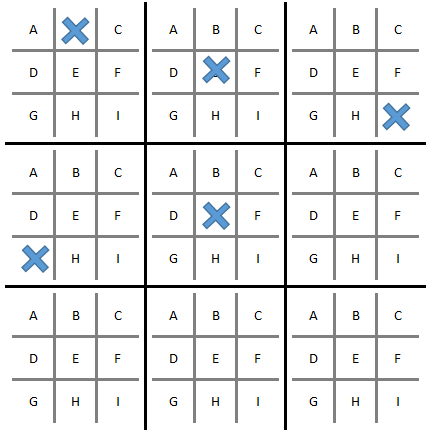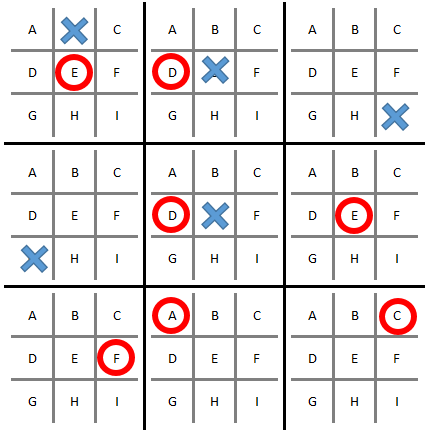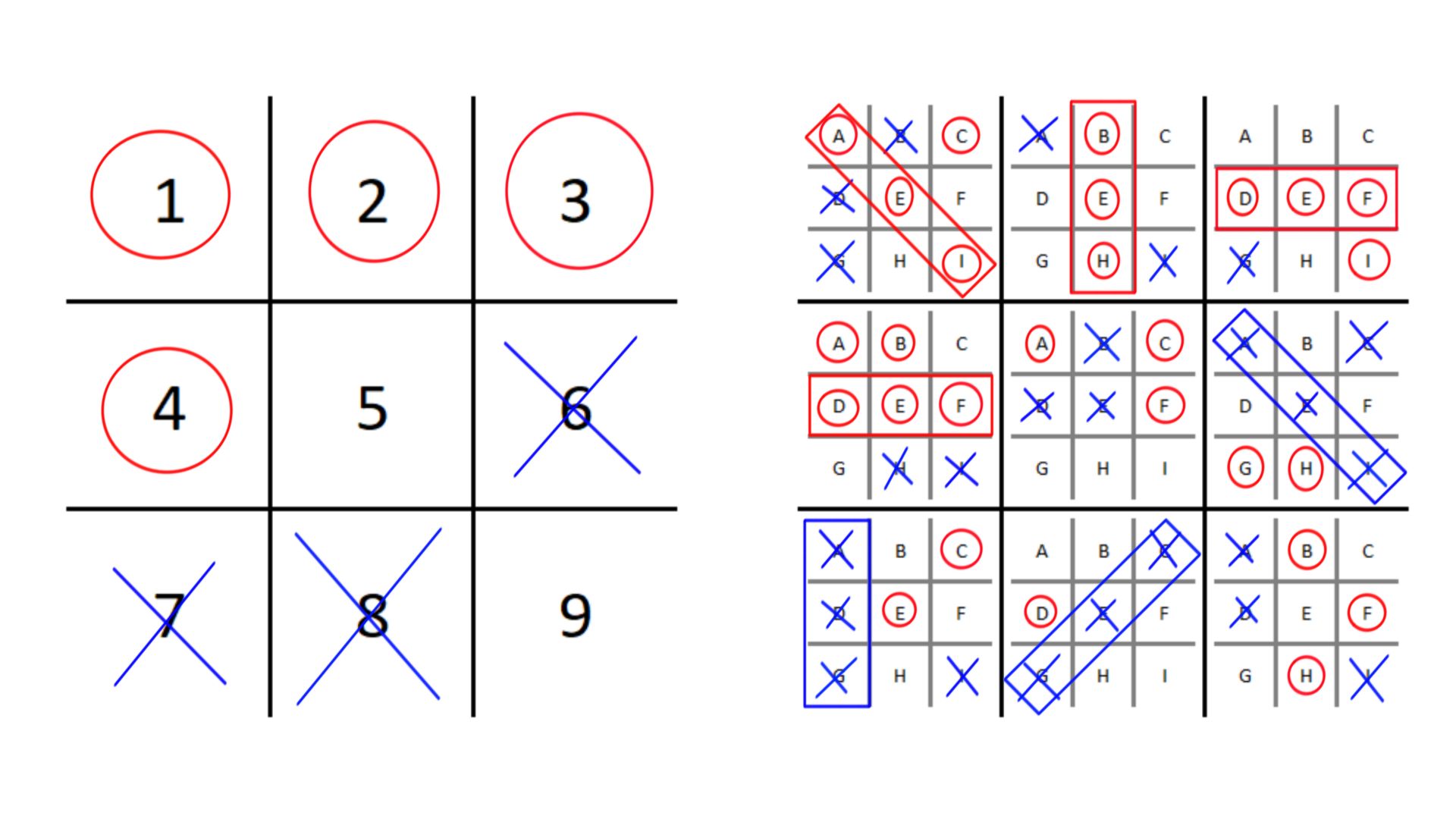This puzzle is part of the Monthly Topic Challenge #3: Pencil and Paper Games
Introducing a new tic-tac-toe variant of my own devising (at least I haven't found an equivalent anywhere online).
Background and example
Xavier and Olivia are playing 'Pigpen tic-tac-toe'. The game is played on a large tic-tac-toe grid (spaces numbered 1 through 9), where each of the nine playing spaces contains another smaller tic-tac-toe mini-grid with spaces labelled alphabetically, A through I:
On turn one, the starting player - Xavier, here - spells out a real word of two letters or more using only the letters A through I, and - starting with the mini-grid in space 1 - spells out the word in order, one letter per space, placing their symbol on each letter that they use. For example, if Xavier opened the game with 'BEIGE', he would mark off the 'B' in mini-grid 1, the 'E' in mini-grid 2, the 'I' in mini-grid 3, the 'G' in mini-grid 4, and the 'E' in mini-grid 5, like so:
The second player would then play a word of their own, placing the first letter in the same mini-grid in which the previous player ended their turn. In our example game, since Xavier's word finished in mini-grid 5, Olivia must place the first letter of her word in mini-grid 5 also. Crucially, she cannot use a letter that has already been played - in our example game, her word cannot begin with the letter 'E'. A valid play might be 'DEFACED', for example, which she then plays, wrapping round from mini-grid 9 to mini-grid 1 when required:
Players continue, alternating turns, spelling out words using unclaimed letters. If at any point they place three symbols in a straight line (horizontally, vertically, or diagonally) in the same mini-grid - as per standard tic-tac-toe rules - they win that mini-grid and can claim the numbered space in the large main grid for themselves, marking that with their symbol. That mini-grid is then retired and plays no further part in the game. When spelling out words in future turns, players simply skip over completed mini-grids and place their letter in the next still-active mini-grid instead. If a mini-grid is won on the final letter of a word, the next player places the first letter of their next word in the next still-active mini-grid instead.
Summary of rules
- Two players take it in turns to spell out words of two letters or more using unclaimed letters in consecutively-numbered mini-grids, one letter per grid. From mini-grid 9, play wraps around to mini-grid 1.
- The first player places their first letter in mini-grid 1; all subsequent turns begin using the same mini-grid in which the previous player finished their turn*.
- If a player places three identical symbols in a row within the same mini-grid, they win that grid and add their symbol in the corresponding space of the large main grid. Multiple mini-grids may be completed in this way within the same turn.
- Mini-grids that have been won by a player - or have reached maximum capacity without a winner - are retired from the game and must be skipped over on subsequent turns, placing the next letter in the next still-active mini-grid instead.
- The game ends when all mini-grids are won or filled to capacity without a winner, or when both players agree that no further words can be played.
* Unless a mini-grid is won on the final letter of a word, in which case the next player places the first letter of their next word in the next still-active mini-grid instead.
Who wins? Well, there are two possible scoring variants:
Winning the game:
In The Basic Variant, whichever player claims the most individual spaces in the large main tic-tac-toe grid is the winner.
In The Advanced Variant, players score points for spaces claimed and lines of three symbols formed in the large main tic-tac-toe grid: 1 point for each space claimed, plus a bonus of 5 points for the first player to form a line of three identical symbols in a row, and a bonus of 3 points for each subsequent line of three identical symbols in a row. The winner is the player with the highest points total.
The puzzle
Here's the thing - Xavier and Olivia can't decide which winning rule variant to play... Given clues to the words each of them played during their turns (in order), starting the game from scratch, can you reconstruct the game, and tell me whether the choice of winning rule variant would have made any difference to the result?
X1: Arrogant.
O1: A horse's food holder.
X2: An insect.
O2: Stranded.
X3: Performance.
O3: Leader.
X4: Large.
O4: Husks.
X5: Notion.
O5: Offer.
X6: "That man."
Clue enumerations (in order of increasing length): 2, 3, 3, 3, 4, 5, 5, 6, 7, 7, 9.










